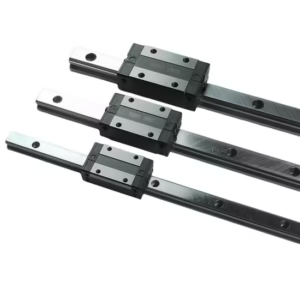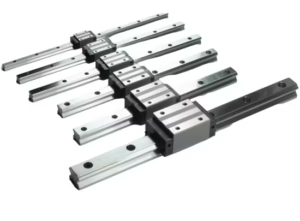Linear rails and slides are essential components in modern machinery, automation systems, and precision equipment. They enable controlled, smooth, and accurate linear motion, ensuring reliability, efficiency, and long-term performance. From CNC machines to 3D printers, robotic arms, medical instruments, and industrial automation, linear rails and slides provide the backbone for precise motion control.
This guide explores the types, design principles, components, materials, advantages, selection criteria, installation, maintenance, and applications of linear rails and slides. By the end, engineers, technicians, and hobbyists will have a thorough understanding of how to optimize and maintain these critical components.
Table of Contents
What Are Linear Rails and Slides?
Components of Linear Rail Systems
Types of Linear Rails and Slides
Design Principles and Mechanics
Materials Used
Advantages of Linear Rails and Slides
Applications Across Industries
Selection Criteria
Installation and Alignment
Maintenance and Lubrication
Common Issues and Troubleshooting
Innovations and Future Trends
Frequently Asked Questions
Conclusion
1. What Are Linear Rails and Slides?
Linear rails are precision-ground tracks that provide a pathway for linear motion. Linear slides, also called linear guides or carriages, move along these rails with minimal friction. Together, they create a system that supports accurate, smooth, and repeatable motion in one direction.
Linear rails and slides are designed for applications requiring high precision, load capacity, and rigidity. They are widely used in industrial machinery, automation, robotics, 3D printing, and medical devices.
2. Components of Linear Rail Systems
A linear rail system consists of several key components:
2.1 Linear Rail
A precisely machined track that provides the path for the linear slide. Rails are typically made of hardened steel for durability and wear resistance.
2.2 Linear Slide / Bearing Block
The moving carriage that glides along the rail. It houses rolling elements such as balls or rollers that reduce friction.
2.3 Rolling Elements
Balls or cylindrical rollers circulate within the slide, providing smooth motion and load distribution.
2.4 End Caps
Prevent rolling elements from falling out and facilitate circulation within the slide.
2.5 Lubrication System
Some systems feature built-in lubrication ports, wicks, or grooves to ensure long-lasting smooth movement.
3. Types of Linear Rails and Slides
Linear rail systems come in various designs for different performance requirements:
3.1 Profiled Rail Systems
Design: Rectangular rails with recirculating ball bearings in the slide.
Use: CNC machines, industrial automation, robotics.
Advantages: High rigidity, load capacity, and accuracy.
3.2 Round Shaft Systems
Design: Cylindrical rails with matching round slides.
Use: Light-load machinery, compact devices.
Advantages: Easy installation, cost-effective.
3.3 Cross-Roller Slides
Design: Rollers arranged in a cross pattern to support multi-directional loads.
Use: Robotics, precision tables.
Advantages: Handles radial, axial, and moment loads efficiently.
3.4 Miniature Linear Guides
Design: Small-scale rails and slides.
Use: Laboratory equipment, 3D printers, light automation.
Advantages: High precision in compact form factor.
3.5 Telescopic Slides
Design: Nested rails that extend fully, often in drawers or industrial enclosures.
Use: Storage systems, inspection tables.
Advantages: Full extension and smooth movement in compact space.
4. Design Principles and Mechanics
4.1 Load Distribution
Linear slides distribute loads evenly across the rail, minimizing localized wear and enhancing lifespan.
4.2 Friction Reduction
Rolling elements reduce friction compared to plain sliding surfaces, resulting in smoother motion and lower energy consumption.
4.3 Recirculation Mechanism
Balls or rollers circulate within the slide using recirculation paths, enabling continuous motion without interruption.
4.4 Rigidity and Accuracy
Profiled rails increase rigidity, reduce deflection, and ensure precise movement. This is crucial for machining, robotics, and high-precision tasks.
5. Materials Used
Material selection affects performance, durability, and suitability for environments:
5.1 Steel
High strength and wear resistance
Common in industrial applications
5.2 Stainless Steel
Corrosion-resistant for humid or chemically aggressive environments
Ideal for medical, food, and pharmaceutical industries
5.3 Aluminum
Lightweight and corrosion-resistant
Used in aerospace or portable machinery
5.4 Polymers and Composites
Used in cages, seals, and low-friction components
Reduce noise and enable cleanroom applications
6. Advantages of Linear Rails and Slides
Precision: Maintains accurate and repeatable linear motion.
Low Friction: Smooth movement reduces wear and energy consumption.
High Load Capacity: Handles axial, radial, and moment loads.
Durability: Long lifespan when properly maintained.
Versatility: Applicable in CNC machines, robotics, medical instruments, 3D printers, and automation.
Noise Reduction: Rolling elements reduce operational noise.
7. Applications Across Industries
7.1 CNC Machines
Linear rails guide tool heads, spindles, and tables with high precision for cutting, milling, and engraving.
7.2 3D Printing
Slides provide smooth and precise motion for print heads and beds, ensuring accurate layer deposition.
7.3 Robotics
Supports linear motion in robotic arms, automated assembly lines, and pick-and-place operations.
7.4 Automation Systems
Used in conveyors, automated packaging, inspection, and testing machinery.
7.5 Medical Equipment
Ensures precise motion in imaging machines, surgical robots, and laboratory instruments.
7.6 Aerospace
Supports flight simulators, satellite positioning systems, and aerospace manufacturing tools.
8. Selection Criteria
When selecting linear rails and slides:
Load Capacity: Consider dynamic and static loads.
Precision: Check tolerances, smoothness, and repeatability.
Speed: High-speed applications need optimized rolling elements.
Environmental Conditions: Evaluate temperature, humidity, and contaminants.
Size Constraints: Choose rails compatible with spatial limitations.
Maintenance: Consider lubrication requirements and ease of replacement.
9. Installation and Alignment
9.1 Surface Preparation
Mounting surfaces must be flat, rigid, and clean to prevent misalignment.
9.2 Alignment
Rails should be parallel and straight. Misalignment leads to uneven wear and reduced accuracy.
9.3 Fastening
Use proper torque specifications to avoid distorting the slide or rail.
9.4 Testing
Check smooth motion under load before operational use.
10. Maintenance and Lubrication
Proper maintenance extends system life:
Cleaning: Remove dust, debris, and contaminants.
Lubrication: Apply compatible oil or grease regularly.
Inspection: Monitor for wear, corrosion, or damage.
Replacement: Replace worn components promptly.
11. Common Issues and Troubleshooting
Noise or Vibration: Often caused by misalignment or insufficient lubrication.
Sticking or Jamming: Caused by dirt, debris, or damaged rolling elements.
Excessive Wear: Results from overload, contamination, or improper installation.
Corrosion: Occurs in humid or chemically aggressive environments.
12. Innovations and Future Trends
High-Speed Slides: Optimized for ultra-fast automation and robotics.
Miniaturization: Smaller rails and slides for compact machinery.
Integrated Sensors: Load, temperature, and position monitoring.
Advanced Materials: Coatings and polymers for improved durability and lower friction.
13. Frequently Asked Questions
Q1: What is the difference between linear rails and slides?
A1: Rails are the stationary guide, and slides (blocks) move along the rail, providing low-friction linear motion.
Q2: Can linear rails be used outdoors?
A2: Stainless steel or coated rails are suitable for outdoor use and humid environments.
Q3: How often should linear rails be lubricated?
A3: Depending on usage, lubrication may be weekly, monthly, or as specified by the manufacturer.
Q4: What is the lifespan of a linear rail system?
A4: With proper installation, alignment, and maintenance, linear rails and slides can last for many years, even under heavy industrial use.
14. Conclusion
Linear rails and slides are vital for precise, smooth, and reliable linear motion across diverse industries. From CNC machining and 3D printing to robotics, medical devices, and aerospace, these systems ensure accuracy, durability, and operational efficiency. Understanding their mechanics, materials, installation, maintenance, and application enables engineers and technicians to optimize performance and extend the life of their machinery.
Proper selection, installation, and maintenance are critical to achieving the full benefits of linear rails and slides, ensuring precision and efficiency for years of reliable operation.



